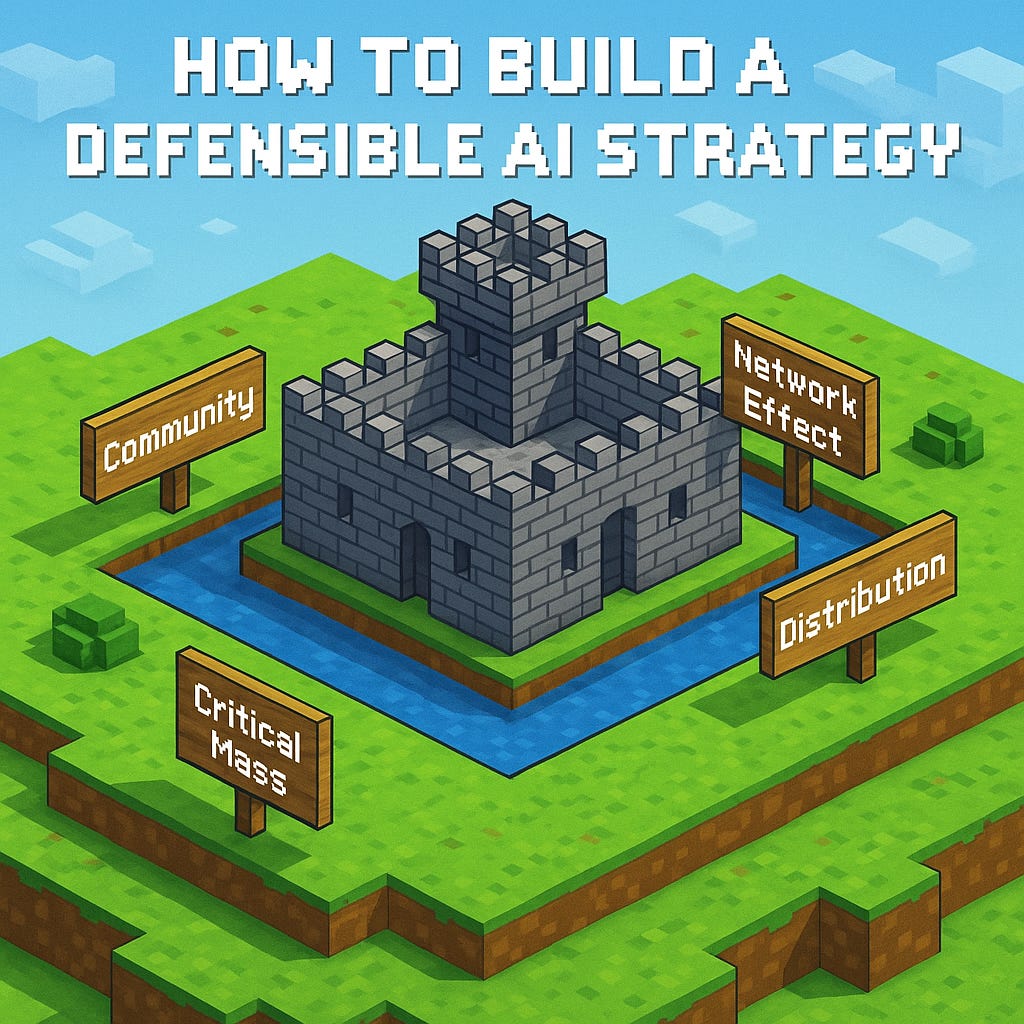How to build a defensible AI strategy
In a world of zero time-to-market, strategy is your only edge.
The competition among AI startups is brutal.
About a decade ago, a startup would get coverage on TechCrunch for its funding round, and a Chinese company would clone that product in about a week — regardless of how good (or stupid) the idea was. Today, you can use tools like Replit, ClaudeCode, and 8n8 to prototype a clone in 18 minutes and ship an MVP in about a day.
But that’s you — just one person. Not a team of 38 developers sitting in Shanghai.
Right now, building products this way still requires some technical skill — ideally, you’re an experienced software developer. But tomorrow? Tomorrow, a non-technical founder will ship a first-version product in nine minutes.
Think about that for a second. You’ve spent 10× that amount of time in at least one meeting with no outcome. What are the implications for the startup ecosystem as time to market approaches zero?
What are the implications for the startup ecosystem as time to market approaches zero?
You need a defensible AI strategy that builds a moat around your startup idea. Because ideas are no longer a dime a dozen — real, functional products are now too.
In the age of AI, your product’s success depends on four forces: community, network effect, distribution, and critical mass. These aren’t new concepts — but they’re no longer nice-to-haves. They need to be baked into the DNA of your company.
Now, if you’ve got an idea that sparks curiosity and has real revenue potential, by all means — ship it and generate cash flow. Then, focus all your energy on making it defensible.
Community
Building a community is more than just throwing up a Discord server and calling it a day. Discord, forums, and other platforms are just that — tools.
To build a real community, you need:
A clear pain point — When you solve a problem that many people feel, the community often builds itself. Don’t just be another tool — create something people have been waiting for.
A captivating vision — Don’t try to boil the ocean on day one. Go all in on one neglected pain point, but show your customers — your community in the making — where you’re heading.
Engaged customers — If people say “that’s cool” but don’t buy your $49 Starter Plan, you’re not on the path to building a community. You need customers who are excited to pay — and ask for features they’ll pay a premium for.
Your presence — Waiting a week to answer a question that 83 others also have is a great way to kill momentum. Show up daily. Multiple times a day. Over time, your presence will lead to peer-to-peer support — but only if you’re a consistent voice within your community.
Network Effect
As more people use your AI, the experience should get better. The benefits of network effects are well-established, but few AI products today have them baked into their model.
Over the next five years, 1,000+ companies will offer AI agents for call centers and other inbound conversations. But because these calls happen in silos — one customer, one AI Agent — customer Jack gains nothing from customer Jane’s interaction.
To create a network effect in your AI product, think about crowd-sourcing, collaboration, or marketplace features. A product like Gong benefits from a network effect: as an organization’s conversational intelligence dataset grows, the value of the product increases — and switching costs rise.
Distribution
Buying clicks shouldn’t be your long-term growth strategy. While plenty of people hawk step-by-step guides for “repeatable” growth strategies, proceed with caution when following their advice. Instead, here are four ideas you should consider:
Become the Distributor — Platforms like Roblox and Salesforce enable others to build and distribute on top of them. How can you help AI companies elegantly distribute their products?
Become a Thought Leader — Most “thought leadership” is outsourced fluff. Real thought leaders provoke new conversations. What perspective can you offer that cuts through the noise?
Become a Storyteller — A great story generates buzz, referrals, press — and momentum. It’s how you become Product of the Week on Product Hunt or go viral on YouTube. What’s the story that will spark an emotional response from your target market?
Become a Hustler — There are dozens of AI SDR tools on the market — use one. What irresistible offer can you put in front of your target market today?
Yes, these are high-level ideas and not a detailed playbook. An entire book could be written on distribution for AI products — and we’ll go deeper in future posts.
Critical Mass
You can have every other piece of your defensible position in place — but if you don’t reach critical mass fast enough, a competitor can still swoop in and steal your community.
A niche AI product for ski slope operators in North America may only need 50–100 customers to reach critical mass. But a broadly applicable product that any company could use like an AI SDR tool may need 500K–1M customers to gain the kind of mindshare that’s hard to replicate.
Critical mass is about planting doubt in a prospect’s mind. You want them to disregard anything that isn’t your product without hesitation. You want them thinking:
“Everyone in my network uses this. They rave about it. I already know it’s packed with value — why would I even consider anything else?”
When you reach critical mass — and layer in the other three defenses — you don’t just fend off competitors. You unlock compounding growth.
What part of your product experience gets better as more people use it?


